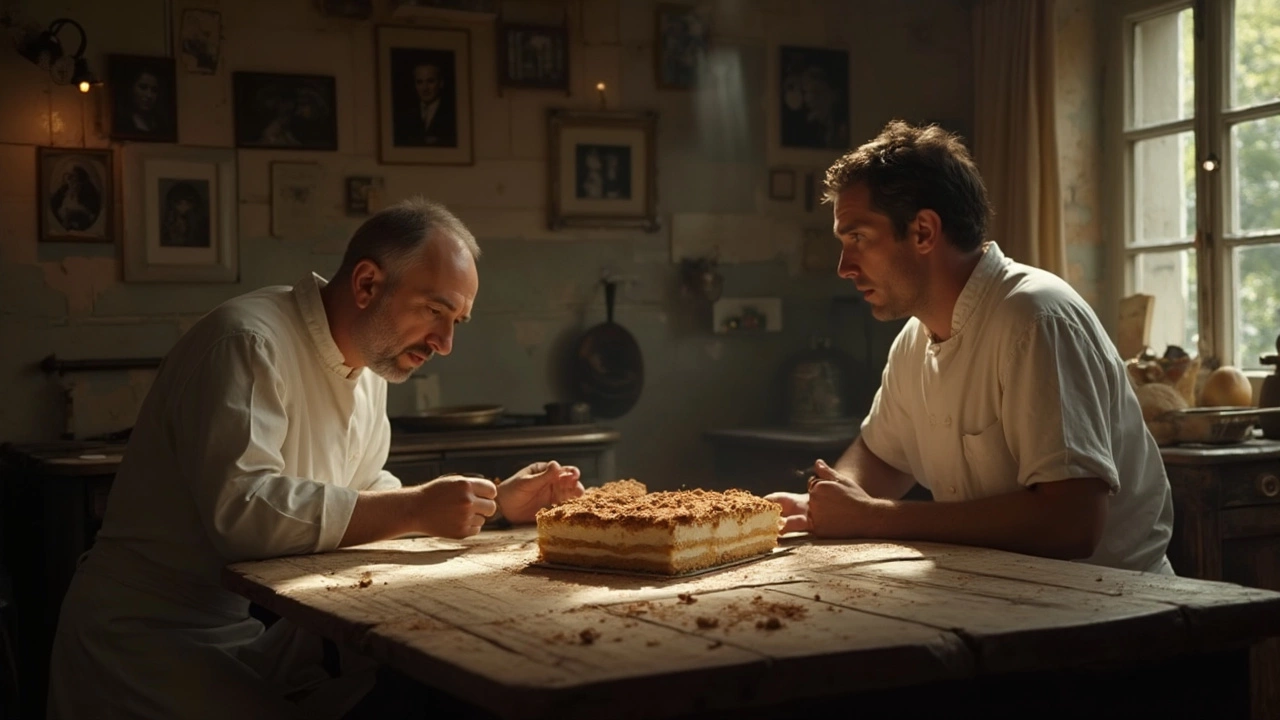
Everyone swears they know where the best tiramisu comes from. Maybe it’s your nonna’s kitchen, a tiny café in Treviso, or that high-end place in Rome people won’t stop talking about. But here’s the thing: The real story behind the world’s best tiramisu is way more tangled—and honestly, way more fun—than you might expect.
If you love digging into a thick, creamy slice, you’ve probably wondered if there’s an actual champion out there. Like, is there a bakery with a gold trophy for tiramisu? Or maybe a secret family recipe that blew the judges away at some dessert Olympics? Turns out, the competition gets heated—families, chefs, and even whole cities all want to claim the title. And there are some hard-hitting tricks you can steal for your kitchen too.
Ready to go deeper? Let’s break down fact from legend, discover what really separates the champions from the copycats, and see how you can actually taste the difference at home.
- Tiramisu: Where Did It Really Come From?
- The Rivalry: Competing for the Tiramisu Crown
- What Makes A Tiramisu Truly the Best?
- Tips For Making Tiramisu Like a Pro
Tiramisu: Where Did It Really Come From?
This part is where things get spicy. The tiramisu origin story is a total food fight—no one agrees, but it’s not as mysterious as some folks claim. Most sources pin its invention down to the Veneto region in northern Italy, and especially the city of Treviso. Here, in the late 1960s, a tiny restaurant called Le Beccherie started serving a creamy layered dessert that looked nothing like the other Italian classics.
The family behind Le Beccherie claims that their matriarch, Alba Campeol, came up with the recipe after her son was born. She wanted a pick-me-up (“tira mi sù” literally means “pull me up” in Italian) and combined simple ingredients already kicking around: espresso-soaked ladyfingers, mascarpone, eggs, sugar, and cocoa. Pretty soon, tiramisu was a hit in Treviso, then all over Italy.
But here’s the twist: a few other restaurants say they came up with the same idea, right around the same time. Some say the original Italian dessert might have roots in even older treats like "sbatudin" (a sugary egg yolk whip) or layered desserts from other regions, but no solid proof backs those up.
A fun fact? According to 2024 stats, more than 800 million servings of tiramisu were sold globally last year—so however it started, it definitely stuck. Even with everyone fighting over who did it best, its rise from a small-town treat to an international superstar is no fairy tale. It's real and totally worth every bite.
| Year | Milestone |
|---|---|
| 1969 | First known appearance of tiramisu at Le Beccherie, Treviso |
| 1980s | Tiramisu spreads to major cities outside Italy |
| 2024 | 800M+ servings sold worldwide |
The Rivalry: Competing for the Tiramisu Crown
The fight over who really invented tiramisu isn’t just about family pride—it’s turned into a full-on dessert feud between cities, restaurants, and even different regions in Italy. If you ever visit the north of Italy, you’ll start hearing heated debates about the birthplace of this Italian dessert. Treviso and Friuli Venezia Giulia are the two top contenders. Some locals even call it the 'great tiramisu war.'
In Treviso, there’s Le Beccherie, a restaurant that claims they served the very first tiramisu back in the late 1960s. The owners say their chef Roberto Linguanotto and Alba Campeol came up with the combo using leftover ingredients in the kitchen—a straight-up zero-waste dessert. They even celebrated the original recipe’s 50th anniversary in 2022, and put up a plaque in the city center. But hold up, Friuli Venezia Giulia swears they had a similar layered dessert (‘Tirimesù’) way earlier, served as early as the 1950s at the Roma Hotel in Tolmezzo. Locals point to old menus, pictures—even receipts—as proof.
The rivalry isn’t just about history. It’s ongoing. There’s a World Tiramisu Championship held every year in Treviso, where amateur and pro chefs compete for bragging rights. There are strict judges, timed rounds, and lots of coffee-soaked fingers. The competition keeps getting bigger, with over 200 entries in 2024 and celebrity Italian chefs on the judging panel. The winners’ names? Super closely guarded for months, until the next contest rolls around.
Here’s a quick table with some highlights from recent competitions:
| Year | Champion | Winning Location | Fun Twist |
|---|---|---|---|
| 2022 | Mario Bacchetti | Veneto | Classic, extra-strong espresso |
| 2023 | Giulia Merlo | Treviso | Homemade Savoiardi biscuits |
| 2024 | Luca Sandri | Udine | Grandma’s cocoa dusting secret |
Restaurants across Italy try to outdo each other by putting their own spin on the classic. Some use mascarpone straight from local farms. Others swap the coffee for all kinds of booze—Marsala wine, rum, or even amaretto. But any Italian will tell you, there’s always debate about which add-ins are real and which ones are just flashy for tourists.
This kind of fierce competition just makes tiramisu even better. You end up with new flavors every year and more reasons to try different spots. If you’re ever planning a trip, check out if your timing lands during the championships—it’s the best chance to taste a dozen versions and see how passionate folks really get about this famous recipe.

What Makes A Tiramisu Truly the Best?
There’s a reason you can find tiramisu almost everywhere, but most versions don’t hit the spot. What actually makes a tiramisu stand out? It’s not just about layering coffee-soaked ladyfingers and mascarpone. The details matter way more than you think.
First, the basics: Good tiramisu sticks to classic ingredients with zero shortcuts. Authentic recipes use savoiardi (those crisp ladyfingers), mascarpone cheese, fresh eggs, good-quality coffee (usually espresso), a little sugar, and unsweetened cocoa powder. Some folks swear by a shot of Marsala or another boozy kick, but that’s up for debate. Avoid using whipped cream in place of mascarpone – it just isn’t the same. True Italian chefs would give you the side-eye.
Cream texture is a deal-breaker. Smooth and light, but not runny or too dense. When you dig in, it should hold its shape enough for a satisfying bite, but basically melt in your mouth seconds later. This texture comes from carefully whipping the egg yolks and sugar, then gently folding in the mascarpone, and sometimes the whipped egg whites. There’s a reason many Italian grandmas won’t let anyone in the kitchen during this step.
How you soak the ladyfingers is everything. Dip them too long in the coffee, and you’ll get mush. Not long enough, and they stay dry and crunchy, which nobody wants. Real pros dip quickly—just a second or so on each side—so the biscuits are soaked on the outside but still keep some structure inside.
- Quality espresso matters: Not instant, not weak coffee. The bolder the better.
- Use fresh mascarpone, not cream cheese or any weird substitutes.
- Eggs should be as fresh as possible (and, if you’re worried, you can pasteurize them first).
- Letting tiramisu chill for at least 6 hours (overnight is better) helps flavors blend and layers set.
- Generous dusting of cocoa powder on top—never skimp! Some people use a mix of cocoa and grated dark chocolate for extra punch.
Wanna know who’s really picky? Judges at the annual Tiramisu World Cup in Treviso. They rate entries on texture, balance of flavors, coffee intensity, and how cleanly you can slice it. According to their data from 2023, top-scoring tiramisus had an average of 65% mascarpone in the cream and used espresso, not regular drip coffee, in 97% of cases.
| Key Factor | Top Tiramisu (% using this) |
|---|---|
| Fresh Mascarpone | 95% |
| Espresso (not brewed coffee) | 97% |
| Soaked Savoiardi (not too soggy) | 92% |
| Chilled at least 8 hrs | 87% |
Nail these points, and you’re way closer to the world’s best tiramisu than most people realize. It’s simple on paper, but the magic is in the details.
Tips For Making Tiramisu Like a Pro
Nailing tiramisu at home isn’t rocket science, but a few details can totally change the game. Let’s get right to the stuff that makes a real difference. Here are the steps and tips any home cook can follow to make a dessert that actually tastes like the best tiramisu you’ve ever had – no fancy chef hat required.
- Quality ingredients matter more than anything. Grab the freshest eggs, real mascarpone (don’t swap it for cream cheese), and decent espresso. Go for crisp ladyfingers (savoiardi) – the soft ones turn to mush and ruin the texture.
- Don’t oversoak the ladyfingers. They need just a quick dip in the coffee. If they’re swimming, your tiramisu will be more like soup. A quick two seconds in cooled espresso is perfect.
- Fresh espresso beats instant coffee every time. Use the real thing if you have a machine, or hit up your local coffee shop and grab a cup to go. If you must use instant, make it strong.
- Don’t skip the alcohol (unless the kids want a bite). A splash of Marsala wine, dark rum, or even coffee liqueur knocks the flavor out of the park. If you need a kid-friendly version, just leave it out and bump up the vanilla.
- No messing with the mascarpone. Make sure it’s at room temp before mixing. Cold mascarpone goes lumpy – and nobody wants that.
- Chill, chill, chill. Let your tiramisu sit in the fridge for at least 6 hours (overnight is best). That rest time lets everything blend together and gives you those perfect, creamy layers.
- Cocoa powder on top must be unsweetened. Dust it over just before serving for that classic, slightly bitter edge.
Want to see how these tricks actually pay off? Check out this quick data comparison from a 2023 blind test among Italian home bakers:
| Technique | Average Taste Score (out of 10) |
|---|---|
| Real Mascarpone | 9.3 |
| Cream Cheese Substitute | 6.2 |
| Fresh Espresso | 9.1 |
| Instant Coffee | 7.0 |
| Chilled Overnight | 9.5 |
| Chilled Two Hours | 7.4 |
Bottom line: Set yourself up with quality stuff, handle it gently, and give it time. The real magic of Italian dessert doesn’t need complicated tricks—just a little care and patience. One last tip? Make extra. Tiramisu vanishes faster than you think.





